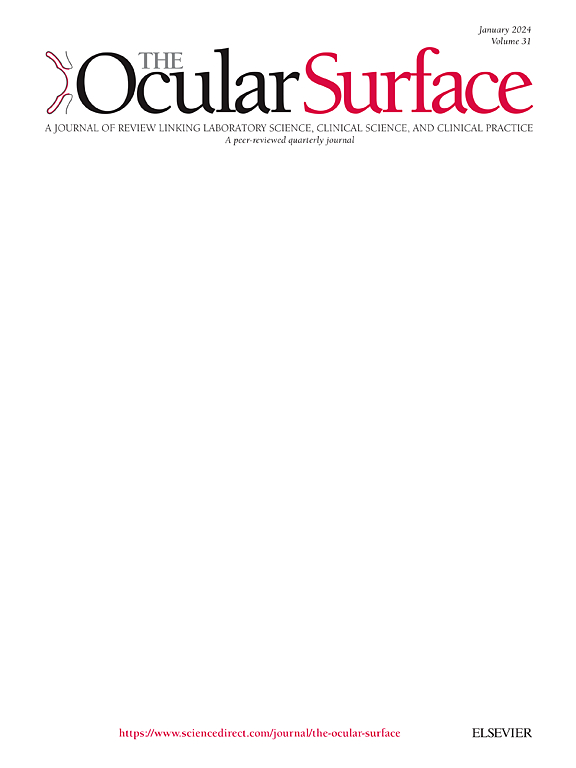术前撕裂蛋白组基线差异与屈光术后持续疼痛有关。
IF 5.6
1区 医学
Q1 OPHTHALMOLOGY
引用次数: 0
摘要
目的:大多数接受屈光手术的患者都有很好的结果,但有一部分患者在手术后会经历持续的眼睛疼痛。我们假设术前泪液蛋白在术后出现疼痛的患者中是不同的。方法:接受屈光手术(LASIK或PRK)的患者在术前(基线)和术后提供泪液样本和眼部疼痛报告(数值评定量表(NRS) 0 - 10)。无基线疼痛,但3个月时疼痛(NRS bbbb3)的患者(疼痛组,n=31)与术前或术后3个月无疼痛的患者(无疼痛组,n=47)进行比较。基线样品采用串联质谱分析。基于折叠变化阈值、ROC曲线下面积(AUC)或随机森林分类中特征重要性的差异表达蛋白被识别并用于构建多蛋白模型。结果:39个蛋白在疼痛组和无疼痛组有差异表达。多蛋白模型显示,4种蛋白组成的子集将疼痛组分类,AUC为0.87 (95% CI, 0.79 - 0.96)。该模型在Pain患者中含有2种升高的蛋白(PGRC1和PFD3)和2种降低的蛋白(IBP3和SPB9),呈双向动态作用。结论:对术前撕裂的分析揭示了屈光手术后3个月持续疼痛患者的蛋白质组差异。由于这些泪液样本是在手术前采集的,当患者没有疼痛时,这些蛋白质模式可能有助于发现屈光手术后持续眼睛疼痛的风险生物标志物。本文章由计算机程序翻译,如有差异,请以英文原文为准。
Differences in pre-surgical baseline tear proteome are associated with persistent post-refractive surgery pain
Purpose
Most patients who undergo refractive surgery have excellent outcomes, but a subset experience persistent eye pain after the procedure. We hypothesized that pre-operative tear fluid proteins are distinct in patients who develop pain after surgery.
Methods
Patients undergoing refractive surgery (LASIK or PRK) provided tear fluid samples and eye pain reports (numeric rating scale (NRS) 0–10) before (baseline) and after surgery. Patients reporting no baseline pain, but pain (NRS ≥3) at 3 months (Pain group, n = 31), were compared to patients with no pain before or 3 months after surgery (No Pain group, n = 47). Baseline samples were analyzed by tandem mass tag spectrometry. Proteins demonstrating differential expression based on fold change thresholds, area under the ROC curve (AUC), or feature importance in random forest classification were identified and used to construct multi-protein models.
Results
Thirty-nine proteins showed differential expression between Pain and No Pain patients. Multi-protein models showed that a subset of 4 proteins classified the Pain group with an AUC of 0.87 (95 % CI, 0.79–0.96). This model contained 2 proteins that increased (PGRC1 and PFD3) and 2 proteins that decreased (IBP3 and SPB9) in Pain patients, showing bi-directional, dynamic effects.
Conclusion
Analysis of pre-surgical tears reveals proteome differences in patients who go on to experience persistent pain 3 months after refractive surgery. Since these tear samples were taken prior to surgery, when patients were not experiencing pain, these protein patterns may inform the discovery of risk biomarkers for persistent post-refractive surgery eye pain.
求助全文
通过发布文献求助,成功后即可免费获取论文全文。
去求助
来源期刊

Ocular Surface
医学-眼科学
CiteScore
11.60
自引率
14.10%
发文量
97
审稿时长
39 days
期刊介绍:
The Ocular Surface, a quarterly, a peer-reviewed journal, is an authoritative resource that integrates and interprets major findings in diverse fields related to the ocular surface, including ophthalmology, optometry, genetics, molecular biology, pharmacology, immunology, infectious disease, and epidemiology. Its critical review articles cover the most current knowledge on medical and surgical management of ocular surface pathology, new understandings of ocular surface physiology, the meaning of recent discoveries on how the ocular surface responds to injury and disease, and updates on drug and device development. The journal also publishes select original research reports and articles describing cutting-edge techniques and technology in the field.
Benefits to authors
We also provide many author benefits, such as free PDFs, a liberal copyright policy, special discounts on Elsevier publications and much more. Please click here for more information on our author services.
Please see our Guide for Authors for information on article submission. If you require any further information or help, please visit our Support Center
 求助内容:
求助内容: 应助结果提醒方式:
应助结果提醒方式:


